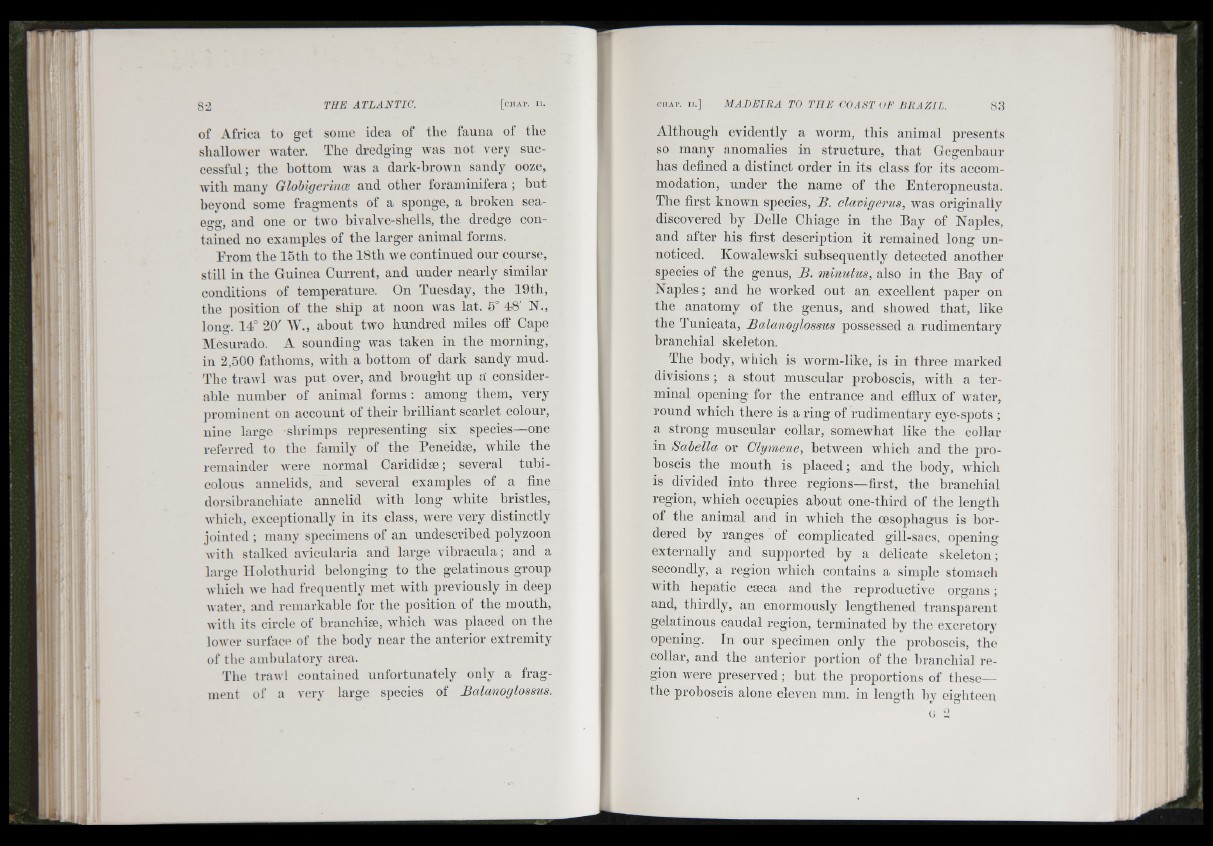
THE ATLANTIC. [ c h a p . II . CHAP. I I .] M A D E I R A TO T H E COAST OF B R A Z I L 83
of Africa to get some idea of the fauna of the
shallower AA’ater. The dredging Avas not very successful;
the bottom AA^as a dark-broAvn sandy ooze,
Avith many Globigeidnce and other foraminifera ; but
beyond some fragments of a sponge, a broken sea-
eo'o*, and one or tAVO hivalve-shells,O * the dredge contallied
no examples of the larger animal forms.
E rom th e 1 5 th to th e 1 8 th Ave co n tin u e d o u r course,
s till in th e G u in e a C u rre n t, a n d u n d e r n e a rly sim ila r
conditions of tem p e ra tu re . On Tuesday, th e 1 9 th ,
th e p o sitio n of th e sh ip a t noon Avas la t. 5° 18' N.,
lono'. 11° 20' AY., a b o u t two h u n d re d miles off Cape
Mesurado. A so u n d in g Avas ta k e n in th e m o rn in g ,
in 2,500 fa th om s, Avith a b o ttom of d a rk san d y mud.
The traw l Avas p u t over, a n d b ro u g h t up a conside rable
n iim h e r of a n im a l forms : am o n g th em , v e ry
])rominent on a c c o u n t of th e ir b r illia n t s c a rle t colour,
n in e la rg e sh rim p s re p re s e n tin g six species—one
re fe rred to th e fam ily of th e Peneidse, AAdiile th e
rem a in d e r AA'ere n o rm a l C a rid id s e ; several tu h i-
colons an n elid s, a n d several ex amples of a fine
d o rs ih ran ch ia te an n e lid Avith lo n g Avhite b ristle s,
AA h ich, ex c ep tio n a lly in its class, Avere v e ry d is tin c tly
jo in te d ; m any specimens of an un d e sc rib ed polyzoon
Avith sta lk ed aAdcnlaria a n d la rg e v ih r a c n la ; an d a
la rg e E lo lo tlm rid b e lo n g in g to th e g e la tin o u s g ro u p
Avhich Ave h ad fre q u e n tly m e t w ith prev io u sly in deep
Avater, an d rem a rk a b le for th e p o s itio n of th e m o n th ,
Avith its circle of hranchias, AAdiich Avas placed on th e
loAver surface of th e hody n e a r th e a n te rio r e x trem ity
of th e an d iu la to ry area.
The traAvl contained unfortunately only a fragment
of a very large species of Balanoglossus.
Although evidently a worm, this animal presents
so many anomalies in structure, that Gegenhaur
has defined a distinct order in its class for its accommodation,
under the name of the Enteropneusta.
The first known species, B. clavigerus, was originally
discovered hy Delle Ghiage in the Bay of Naples,
and after his first description it remained long unnoticed.
Kowalewski subsequently detected another
species of the genus, B. minulus, also in the Bay of
Naples; and he worked out an excellent paper on
the anatomy of the genus, and showed that, like
the T'unicata, Balanoglossus possessed a rudimentary
branchial skeleton.
The body, Avhich is Avorm-like, is in three marked
divisions ; a stout muscular proboscis, with a te rminal
opening for the entrance and efflux of Avater,
round Avhich there is a ring of rudimentary eye-spots ;
a strong muscular collar, somewhat like the collar
in Sabella or Chjmene, betAveen which and the pro boscis
the mouth is placed; and the hody, AAffiich
is divided into three regions—first, the branchial
region, which occupies about one-third of the length
of the animal and in which the oesophagus is bordered
by ranges of complicated gill-sacs, opening
externally and supported by a delicate skeleton;
secondly, a region Avhich contains a simple stomach
AAuth hepatic caeca and the reproductive o rg an s;
and, thirdly, an enormously lengthened transparent
gelatinous caudal region, terminated by the excretory
opening. In our specimen only the proboscis, the
collar, and the anterior portion of the branchial region
AA^ere preserved; but the proportions of these—
the proboscis alone eleven mm. in lenMO h hvt eiohteen
o 2